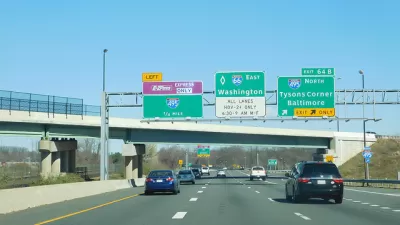The lanes are in use now, operating as High Occupancy Vehicle (HOV) lanes during peak hours. Come December, solo-occupant vehicles will be able to use the converted lanes, providing they have E-ZPass transponders. However, there are some losers.
The losers are those with "Clean Special Fuel plates," e.g., hybrids and electric vehicles, which have been using the HOV lanes by solo drivers. The Virginia Department of Transportation refers to these low or zero emission vehicles generically as "hybrid vehicles." In California, traditional hybrid vehicles, without plug-in battery charging capability, lost their special privileges over six years ago.
Come December, all "clean fuel" vehicles will need to have at least one passenger to use the I-66 HOT lanes toll-free, according to Luz Lazo, transportation reporter for The Washington Post, who has been chronicling the new lanes since at least July.
The new 10 miles of HOT lanes on I-66 are "inside-the-Capital Beltway," from Route 29 in Rosslyn to Interstate 495.
Unlike the 495 and 95 Express Lanes in Northern Virginia that operate 24-7, the I-66 HOT lanes will only function during peak hours and in the peak direction, i.e., they will operate like general purpose lanes during all other times. However, those hours have been expanded. "The new peak hours will be 5:30 to 9:30 a.m. eastbound and 3 to 7 p.m. westbound."
For commuters, adjusting to the new requirements and rules may be the biggest challenge in coming months. This will be the first rush-hour-only, peak-period toll system of its kind in the United States.
All vehicles except motorcycles that use the HOT lanes will need to have E-ZPass accounts. Carpoolers will need to switch to "HOV mode."
Planetizen has also been chronicling the conversion and addition of the new HOT lanes with five posts since June 2015.
Hat tip to Kenyon Karl.
FULL STORY: Virginia’s latest experiment with toll lanes to test thousands of commuters on I-66

Study: Maui’s Plan to Convert Vacation Rentals to Long-Term Housing Could Cause Nearly $1 Billion Economic Loss
The plan would reduce visitor accommodation by 25,% resulting in 1,900 jobs lost.

North Texas Transit Leaders Tout Benefits of TOD for Growing Region
At a summit focused on transit-oriented development, policymakers discussed how North Texas’ expanded light rail system can serve as a tool for economic growth.

Why Should We Subsidize Public Transportation?
Many public transit agencies face financial stress due to rising costs, declining fare revenue, and declining subsidies. Transit advocates must provide a strong business case for increasing public transit funding.

How to Make US Trains Faster
Changes to boarding platforms and a switch to electric trains could improve U.S. passenger rail service without the added cost of high-speed rail.

Columbia’s Revitalized ‘Loop’ Is a Hub for Local Entrepreneurs
A focus on small businesses is helping a commercial corridor in Columbia, Missouri thrive.

Invasive Insect Threatens Minnesota’s Ash Forests
The Emerald Ash Borer is a rapidly spreading invasive pest threatening Minnesota’s ash trees, and homeowners are encouraged to plant diverse replacement species, avoid moving ash firewood, and monitor for signs of infestation.
Urban Design for Planners 1: Software Tools
This six-course series explores essential urban design concepts using open source software and equips planners with the tools they need to participate fully in the urban design process.
Planning for Universal Design
Learn the tools for implementing Universal Design in planning regulations.
City of Santa Clarita
Ascent Environmental
Institute for Housing and Urban Development Studies (IHS)
City of Grandview
Harvard GSD Executive Education
Toledo-Lucas County Plan Commissions
Salt Lake City
NYU Wagner Graduate School of Public Service




























